 United Kingdom (1898)
United Kingdom (1898)Formidable, Irresistible, Implacable, London, Bulwark, Venerable, Queen, Prince of Wales.
WW1 RN Battleships
HMS Dreadnought | Bellerophon class | St. Vincent class | HMS Neptune | Colossus class | Orion class | King George V | Iron Duke class | HMS Agincourt | HMS Erin | HMS Canada | Queen Elizabeth class | Revenge class | G3 classMajestic class | Centurion class | Canopus class | Formidable class | London class | Duncan class | King Edward VII class | Swiftsure class | Lord Nelson class
Invincible class | Indefatigable class | Lion class | HMS Tiger | Courageous class | Renown class | Admiral class | N3 class
The improved Canopus
This “superclass” of eight pre-dreadnought battleships was a same time very close to the Majestic and Canopus, yet they had true turrets and were enlarged Canopus essentially. Design changes were made during construction, so that two-subclasses appeared, the London sub-class, and the Queen sub-class. The Formidable class are often described as improved Majestics, were more enlarged Canopus, but also using Krupp armour in their construction allowing a better protection without speed loss. They were much better protected than the Majestics and faster than the Canopus. Unlike the latter class however, their armour belt ran all the way to the stern, 66 m long, and 4.6 m deep, 230 mm thick. The main battery turrets (Krupp) were 10 inches (250 mm) thick.
The main and secondary armament was also improved, from 35-calibre to 40-calibre for their 12-inch (305 mm) guns and 45-calibre for their 6-inch (152 mm) guns. The main artillery could be loaded at any bearing and elevation and a split hoist with a working chamber beneath the guns reduced chance of a cordite fire spreading out to the magazines. Their improved hull form made them better steamers, and they had inward-turning propellers (reduced fuel consumption). This was however at the expense of manoeuvrability at lower speeds.
Due to service problems with the water tube Belleville boilers the original plans were changed during construction, and HMS Queen was fitted with Babcock & Wilcox cylindrical boilers instead. Her nearly identical sister ship Prince of Wales was fitted with the problematic watertube Belleville boilers.
Queen and Prince of Wales were the last battleships for which Sir William Henry White had sole design responsibility. Like all pre-dreadnoughts, they were outclassed by the dreadnought battleships that began to appear in 1906, although they took on some front-line duties early in World War I.
HMS Formidable
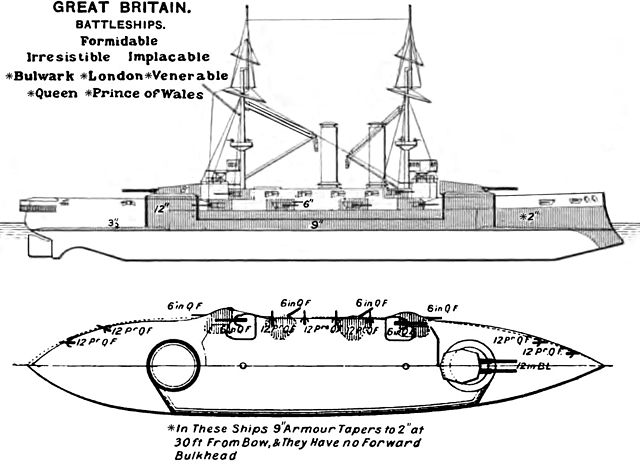
HMS Formidable class battleship Brassey’s 1906
HMS Formidable was commissioned on 10 October 1904 at Portsmouth Dockyard, intended for Mediterranean Fleet at Gibraltar. Refitted in Malta in 1904-1905, she was back home, joining the Channel fleet in 1908 and was paid off at Chatham in 1908, she served with the 1st Division, Home Flee (Nore) and served later with the Atlantic Fleet. in 1912 her crew was reduced and she joined the 5th Battle Squadron, Second Fleet (Nore) up to 1914. She was noted then for serious machinery problems. Based in Portland she patrolled the English Channel, covered the British Expeditionary Force travel to France and manded the Portsmouth Marine Battalion in Ostend. By November she served from Sheerness (possible German invasion of Great Britain) but returned later to Portland in december.
With Vice-Admiral Sir Lewis Bayly from the 5th Battle Squadron on board she participated in gunnery exercises on 1st January 1915 and despite submarine activity had been reported, rough sea and wind seemed to prevent any such threats to even happening. The battleship was steaming at 10 knots at the rear of the squadron, off Portland Bill bu was struck at 02:20 by a torpedo from U-24. She was hit at number one boiler, port side and by 02:40 listed about 20° to starboard and was to be abandoned while darkness was falling. However at 03:05, she was struck by a second torpedo on the starboard side. 80 men were rescued and by 04:50, she rolled over and sank quickly, Captain Loxley remaining on the bridge. She carried with her to the bottom 35 officers and 512 men (from 780). She was the third British battleship to be sunk by then.
HMS Irresistible
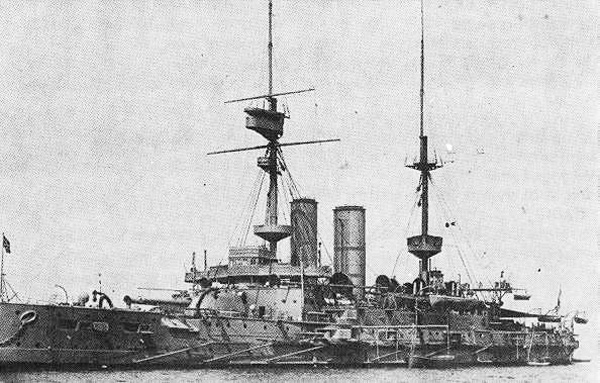
HMS Irresistible was commissioned at Chatham, February 1902 for the Mediterranean Fleet service based at Gibraltar. From May 1902 she visited Augusta (Sicily) and the Piraeus (Greece) but suffered a collision with the Norwegian merchant steamer SS Clive on her way to commission in March 1902 and ran aground at Malta in October 1905, refitted there two times. She was back home to served in 1908 with the Channel Fleet, colliding with a schooner and was later assigned to the Nore Division in 1909, reduced to a nucleus crew by May 1910 and paid off at Chatham. Refitted, she served with the 3rd Division, Home Fleet, Nore. and the 5th Battle Squadron at Portland, patrolling the Channel, coering the Plymouth Marine Battalion landing at Ostend, bridgehead and hinterland operations.
By the fall of 1914 she was attached to the Dover Patrol, shelling German advance along the Belgian coast and the on the East Coast Patrols (Gorleston Raid), and then back to the Channel Fleet in November 1914. She was transferred to Sheerness in November and was back to Portland but by February 1915 she was transferred to the Dardanelle as flagship of the British Dardanelles Squadron until March 1915. She bombarded numerous forts and knocked out two 9.4 in (240 mm) guns at Fort Orkanieh on 25 February, ater relieving the battleship HMS Vengeance as second flagship, British squadron by February until March and supported other landing. On 18 March, she bombarded the Narrows of Çanakkale and Kilitbahir but was badly damaged when pulling off, stricking one mine at about 16:16, woth 150 dead, some drawn and others blast off by Turkish gunners later.
With her starboard engine room flooded, power lost, her midship bulkhead collapsed, badly listing to starboard, down by the stern, she drifted into range and drawn indeed heavy artillery on her for long hours. However her surviving crew except for the captain and volunteers were evacuated on HMS Wear, a detached destroyer. The battleship HLS Ocean tried but failed to tow her being temporarily grounded in the attempt while Irresistible drifted nearer the shore and after the remaining crew was evacuated she was abandoned. Ocean would later struck a mine at 18:05 while withdrawing, but most of ther crew survived and she was also abandoned. The destroyer HMS Jed later torpedoed and sink the two abandoned battleships to prevent their capture.
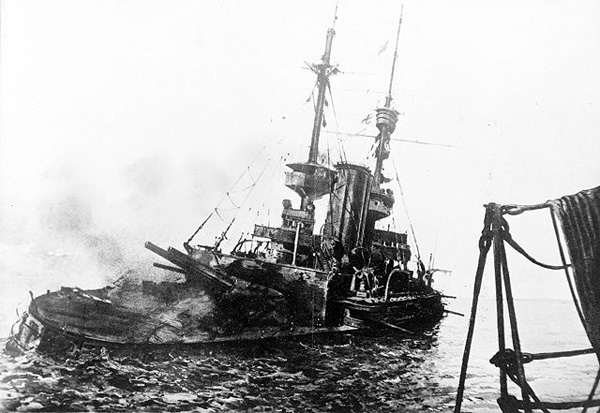
HMS Implacable
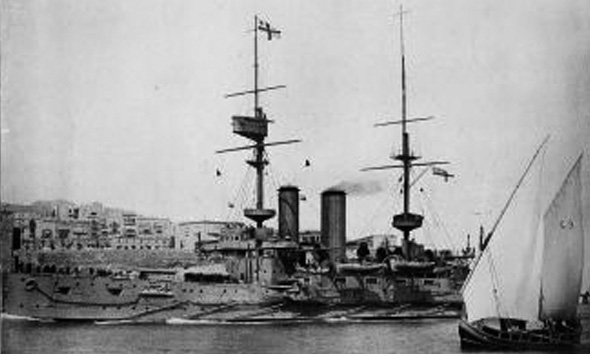
HMS Implacable was commissioned at Devonport by Prince Louis of Battenberg, 10 September 1901. She served on the Mediterranean Statio, being refitted three times at at Malta and joining Alexandria for coronation festivities. She visited Nauplia (Aegean) but suffered a fatal accident on 12 July 1905 (boiler explosion) and another on 16 August 1906. She was refitted at Chatham in 1908-1909, joined the Channel Fleet, Atlantic Fleet and 5th Battle Squadron (Second Home Fleet at the Nore by 1912. in 1914 her unit was transferred to the Channel Fleet at Portland. She was attached to the Dover Patrol and bombered the coast of Belgium in support of Allied forces. Transferred to Sheerness she was transferred to the Dardanelles in March 1915 and served throughout the Dardanelles Campaign. She left England on 13 March 1915 and arrived at Lemnos on 23 March 1915. She supported the main Allied landings at X Beach at Cape Helles on 25 April 1915, and thereafter supported the campaign until May, covering actions on 25 April 1915 and following weeks.
Together with HMS London, Prince of Wales and Queen, she became part of the 2nd Detached Squadron, Adriatic Sea and reinforced the Italian Navy after war was declared against the central powers, based at Taranto, Italy, from May 1915. In November she was transferred to the 3rd Detached Squadron (Salonika) to defend the Suez Canal and assist the French Navy in blockading Greece and Bulgari, and later was based at Port Said, Egypt. She departed for UK, being refitted at Plymouth and later joined the 3rd Detached Squadron at Salonika and by June 1917 was present at Athens during the abdication of King Constantine I. From July she returned to the UK, and paid off at Portsmouth. Her four main-deck casemates on each side were replaced by two 6-inch (152-mm) guns (battery deck) but she was laid up and in March 1918 served as a depot ship (Northern Patrol, Lerwick, Kirkwall, Buncrana). After the war she was paid off, sold and scrapped in 1921.
HMS Venerable, the bad-powered
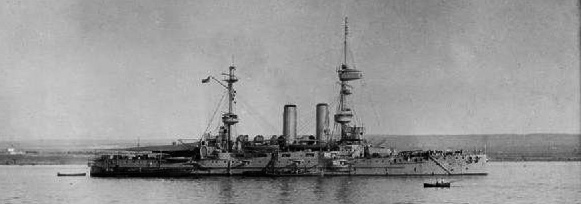
The battleship encountered many delays, due to difficulties with her machinery contractors. Commissioned on November 1902 she became Second Flagship of the Mediterranean Fleet but later ran aground outside Algiers harbor. Refitted at Malta in 1906–1907 she replaced HMS Prince of Wales as flagship until 1908, and was paid off at Chatham, but recommissioned in January 1908 for the Channel Fleet refitted extensively afterwards in 1909. By October she served with the Atlantic Fleet and by May 1912 was transferred at the Nore, 5th Battle Squadron with a nucleus crew. She later served from Portland in the summer of 1914, was full commissioned again and patrolled the English Channel, then Dover Patrol, bombarded German positions along the Belgian coast to support Allied troops off Westende and Lombardsijde. Flagship of the Commander-in-Chief Rear Admiral Sir Horace Hood until October 1914 she was later detached to support the East Coast Patrol (Gorleston Raid), and moved afterwards to Sheerness in November 1914 then back to Portland in December, and again bombarding Westende in March and May 1915. By then she was sent to the Dardanelles, replacing HMS Queen Elizabeth and in August supported supported the assault on Suvla Bay. At Gibraltar for a refit in November-December she joined the Adriatic Sea at Tarento. Back at Portsmouth in December 1916, she was laid up and later in February-March 1918 refitted as a depot ship, based at Portland to assist minelaying trawlers, Northern Patrol, and Southern Patrol. By December 1918 she was disposed of, sold and scrapped in 1921.
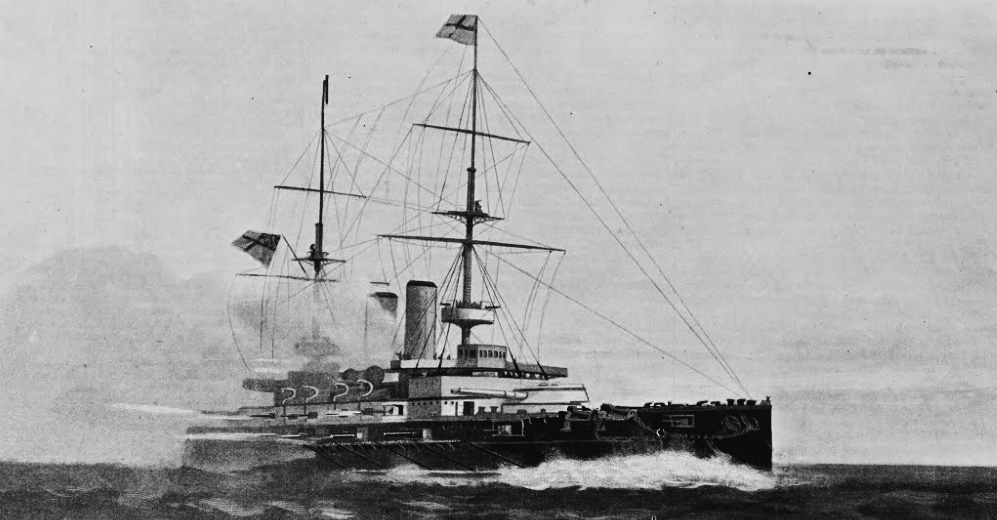
Sub-Class london
The London were similar but had a thinner deck armour and some other detail changes to the armour scheme plus a lower displacement.
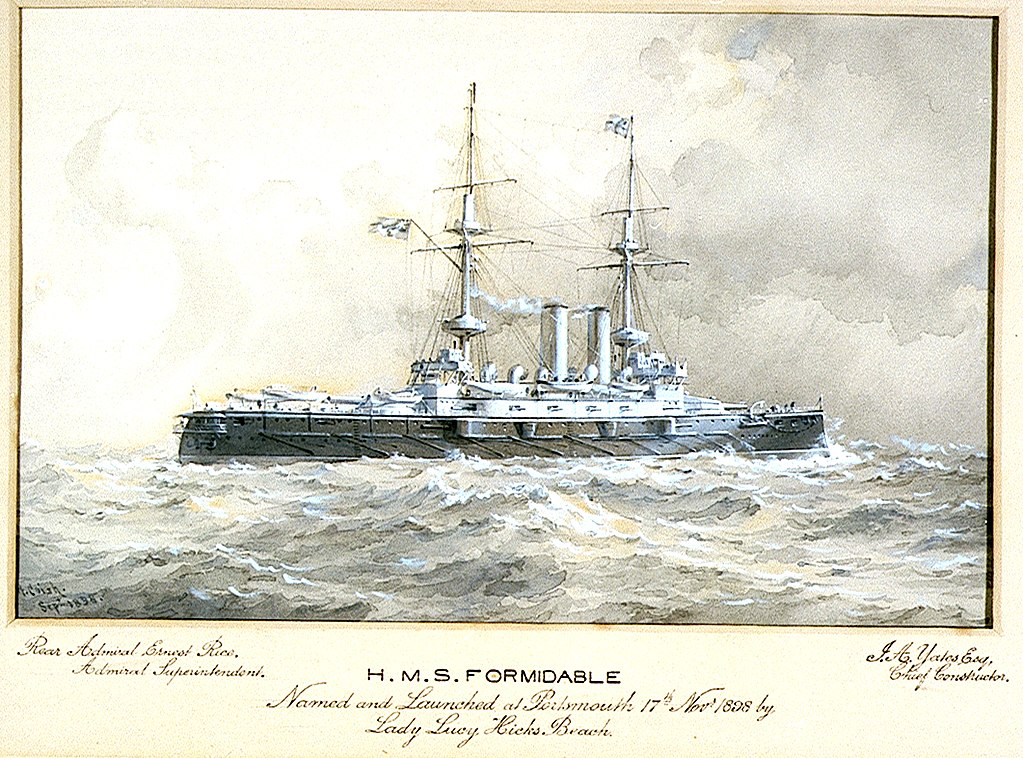
Aquarel of HMS Formidable
These three battleships were very close to the Formidable, varying only by armor details. The front framework protection was lowered in favor of the flanks, the reinforced belt at the front and shortened at the rear. On the other hand, the thickness of the main deck was reinforced throughout the length of the ship, but the intermediate decks were reduced. The ships differed significantly between them: The Queen and Prince of Wales had an open battery for their 76 mm pieces unlike the others. In addition, the boilers of this same HMS Queen were Babcock & Wilcox. They were operational in 1902-1904. Their career was carried out first in the Mediterranean, then these 6 ships returned to the territorial waters.
HMS Bulwark, the cursed battleship
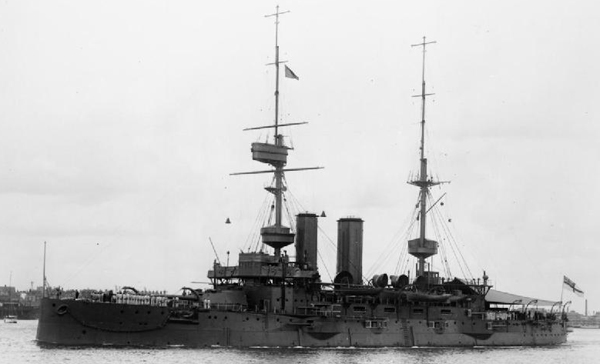
HMS Bulwark
Bulwark entered a long refit after completion for the installation of a modern fire control, commissioned at Devonport in March 1902. She served in the Mediterranean Fleet from Gibraltar, relieving HMS Royal Oak and later became the new fleet flagship on 20 May 1902 in place of HMS Renown. In August 1902 she toured the Agean sea, and was refitted at Malta in 1905–1906, returned and paid off at Devonport in February 1907. She was recommissioned as Flagship of Nore Division, Home Fleet but grounded near Lemon Light on 26 October, and spent monthes at Chatham Dockyard in until 1908. After which she had Robert Falcon Scott of Antarctic as captain, the youngest battleship commander of the fleet.
She served with the Channel Fleet, 2nd Division of the Home Fleet and was refitted again in 1909 and in March 1910 was at the reserve at Devonport, and was refitted again at Chatham in 1911. She grounded twice on Barrow Deep (Nore) in May 1912 and her repaired lasted until June 1912, joining afterwards the 5th Battle Squadron. She served from Portland in 1914, hosted the court martial of Rear-Admiral Sir Ernest Charles Thomas Troubridge (Goeben and Breslau escape) and later was based at Sheerness for a possible German invasion of England. On November 26, 1914, an ammunition barge was carried out in Sheerness, which turned to drama when a charge of black powder exploded, the battleship’s bunkers catching fire and exploding in their turn. HMS Bulwark was literally disintegrated as a result, with only 12 miraculously escaped alive from the inferno.
HMS London
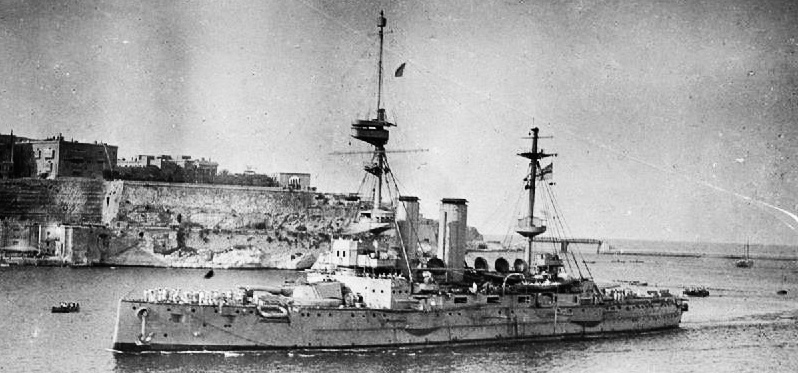
HMS London in Malta, 1915
HMS London commissioned at Portsmouth in June 1902 for service in the Mediterranean Fleet stopped at Gibraltar and arrived at Malta on in mid-July. She was refitted at Malta in 1902–1903 and 1906 and by March 1907 joined the Nore Division, Home Fleet, then Channel Fleet as flagship (Rear Admiral). Refitted at Chatham in 1908 she served from 1910 as Second Flagship, Atlantic Fleet. She was part later of the Second Home Fleet (Nore), crew reduced, and 3rd Battle Squadron. She collided with SS Don Benite in May, then was transferred to the 5th Battle Squadron. There, she received a ramp over her forecastle to launch planes, one being flown by Charles Rumney Samson (first British takeoff from a moving ship in May 1912). The 5th Battle Squadron was assigned to the Channel Fleet, Portland. She covered the British Expeditionary Force and a number of experimental paint schemes were tried this August, although she went back later to battleship grey. She was based at Sheerness but returned to Portland by December 1914 and March 1915 was transferred to the Dardanelles, based from Lemnos in 23 March 1915.
She covered the actions at Gaba Tepe and Anzac Cove. Later with HMS Implacable, Queen, and Prince of Wales she joined the 2nd Detached Squadron guarding the Adriatic Sea from Taranto, Italy. Refitted at Gibraltar in October 1915 she returned home by the fall of 1916. Paid off at Devonport, inactive, she was refited as a minelayer in 1916–1917 at Rosyth. These conversions works consisted into the removal of her 12-inch (305-mm) guns, antitorpedo nets, 6-inch (152-mm) gun, and fitting of a minelaying equipment on her quarterdeck. With rails for 240 mines she had also a concealing canvas screen. From April to 18 May 1918 HMS London was recommissioned at Rosyth and served with the 1st Minelaying Squadron, laying some 2,640 mines in the Northern Mine Barrage.
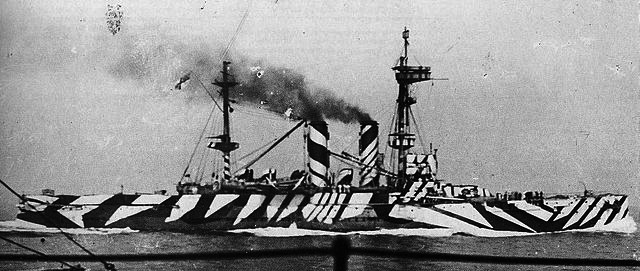
HMS London in may 1918 as a minelayer. from 1914 ger records included patrolling the channel, patrolling with the 5th Squadron, shelling the Belgian coast, covering the Dardanelles operations (relieving HMS Queen Elisabeth), blockading the Adriatic from Taranto, before being converted as a minelayer, operational in January 1918 after conversion, she served until the armistice. She tested a very specific, famous camouflage
Sub-Class Queen
Queen and Prince of Wales were the last of the class, making some sort of sub-class identical except for their open 12-pdr gun batteries relocated on the upper deck amidships and lower displacement, plus minor details.
HMS Prince of Wales
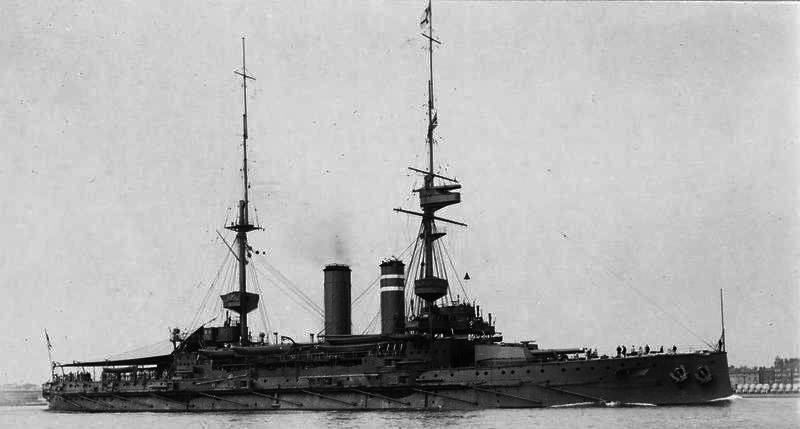
HMS Prince of Wales 1912
HMS Prince of Wales was the fifth of this name in the Royal Navy, completed in March 1904. but only fully commissioned in May for service with the Mediterranean Fleet. She however collided with the merchant steamer SS Enidwen off Oran en route by July 1905 and in April 1906 suffered an engine room explosion. She returned later to the UL for a refit, and at Malta as well. She was transferred to the Atlantic Fleet, flagship by February 1909, damaged by an explosion in a stokeholds by July. Rear-Admiral John Jellicoe hoisted his flag on HMS Prince of Wales by December 1910 and she was refitted at Gibraltar, transferred to the Home Fleets in May, flagship of the 3rd Battle Squadron, First Fleet, and second flagship, Second Fleet, Portsmouth. As part of the 5th Battle Squadron she was accidentally rammed by HMS C32 while during exercises She became flagship of the 5th Battle Squadron in May 1911. By 1914 she served with the Channel Fleet, based at Portland, patrolling the English Channel. She protected the transfer of the British Expeditionary Force, patrolled the eastern end of the Channel, covered the cruiser squadron at the western entrance, covered the Portsmouth Marine Battalion landings at Ostend, and was provisionally based at Sheerness.
She was transferred from 19 March 1915 to the Dardanelles and supported the landings of the 3rd Brigade, Australian Army (Gaba Tepe, Anzac Cove in April 1915. She later reinforced the Italian Navy under orders from Admiral Paolo Thaon di Revel which kept her and Italian modern battleships at Taranto to blockade the Adriatic Sea. She only went to Gibraltar for a refit and returned here until
February 1917. She was placed in reserve on arrival, and became an accommodation ship.
HMS Queen
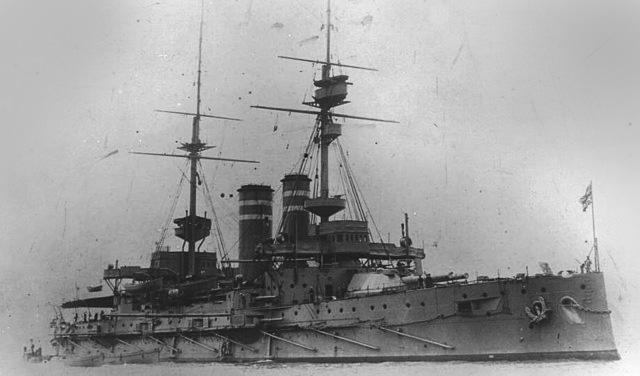
HMS Queen in 1915
HMS Queen was commissioned in April 1904 at Devonport to served with Mediterranean Fleet, refitted at Malta in 1906–1907, and became Fleet Flagship; returned home to be paid off and recomissioned for the Atlantic Fleet. She collided with the Greek merchant steamer SS Dafni at Dover in February 1909, was refitted at Devonport, transferred to the 3rd Battle Squadron, First Fleet the 5th Battle Squadron, Second Fleet and became a gunnery training ship at Portsmouth. From August 1914 she served with the Channel Fleet, Dover Patrol, shelled the coast of Belgium, East Coast Patrol (Gorleston Raid), was based for a tile at Sheerness and eventually by March 1915 transferred to the Dardanelles. She served as Flagship of the 2nd Squadron, covering the ANZAC landings at Gaba Tepe. She was later transferred to the Adriatic Sea on 22 May 1915, based in Taranto. She was refitted in December 1916 – February 1917, a depot ship for the personnel of the Adriatic anti-submarine net barrage patrol. Her crew returned to the UK and she was gradually disarmed, most of her 6-inch (150 mm) deposed in April 1917 and later her 12-inch (300 mm) were deposed and used by the Italian army by October 1917. HMS Queen served as flagship of the British Naval Forces at Taranto until February 1918.
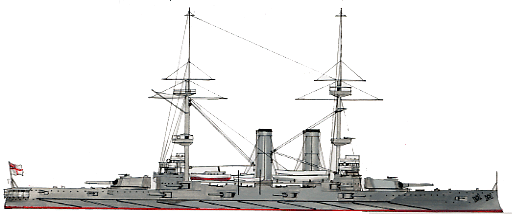
Artist’s Rendition of HMS London
Majestic specifications |
|
| Dimensions | 131.6 x 22.9 x 7.9 m (ft) |
| Displacement | 14,500 t, 15,400-15,700 t FL |
| Crew | 714 Peacetime |
| Propulsion | 2 propellers, 2 TE engines, 3 cyl., 20 Belleville boilers, 15 000 ihp. |
| Speed | 18 kn () |
| Armament | 4 x 305, 12 x 152, 16 x 76, 6 x 47, 4 x 457 mm TTs SM. |
| Armor | Blockhaus 330 armor, belt 230, internal bulkhead 305, turrets 280, casemates 152, bridges 60 mm. |
Sources/Read More
Friedman, Norman (2011). Naval Weapons of World War One. Barnsley: Seaforth
on dreadnoughtproject.org
Burt, R. A. (2013) [1988]. British Battleships 1889–1904. Barnsley: Seaforth Publishing
Gardiner, Robert, ed. (1979). Conway’s All the World’s Fighting Ships: 1860–1905. London: Conway Maritime Press
Formidable-class on Wikipedia

 Latest Facebook Entry -
Latest Facebook Entry -  X(Tweeter) Naval Encyclopedia's deck archive
X(Tweeter) Naval Encyclopedia's deck archive Instagram (@navalencyc)
Instagram (@navalencyc)





 French Navy
French Navy Royal Navy
Royal Navy Russian Navy
Russian Navy Armada Espanola
Armada Espanola Austrian Navy
Austrian Navy K.u.K. Kriegsmarine
K.u.K. Kriegsmarine Dansk Marine
Dansk Marine Nautiko Hellenon
Nautiko Hellenon Koninklije Marine 1870
Koninklije Marine 1870 Marinha do Brasil
Marinha do Brasil Osmanlı Donanması
Osmanlı Donanması Marina Do Peru
Marina Do Peru Marinha do Portugal
Marinha do Portugal Regia Marina 1870
Regia Marina 1870 Nihhon Kaigun 1870
Nihhon Kaigun 1870 Preußische Marine 1870
Preußische Marine 1870 Russkiy Flot 1870
Russkiy Flot 1870 Svenska marinen
Svenska marinen Søværnet
Søværnet Union Navy
Union Navy Confederate Navy
Confederate Navy Armada de Argentina
Armada de Argentina Imperial Chinese Navy
Imperial Chinese Navy Marinha do Portugal
Marinha do Portugal Mexico
Mexico Kaiserliche Marine
Kaiserliche Marine 1898 US Navy
1898 US Navy Sovietskiy Flot
Sovietskiy Flot Royal Canadian Navy
Royal Canadian Navy Royal Australian Navy
Royal Australian Navy RNZN Fleet
RNZN Fleet Chinese Navy 1937
Chinese Navy 1937 Kriegsmarine
Kriegsmarine Chilean Navy
Chilean Navy Danish Navy
Danish Navy Finnish Navy
Finnish Navy Hellenic Navy
Hellenic Navy Polish Navy
Polish Navy Romanian Navy
Romanian Navy Turkish Navy
Turkish Navy Royal Yugoslav Navy
Royal Yugoslav Navy Royal Thai Navy
Royal Thai Navy Minor Navies
Minor Navies Albania
Albania Austria
Austria Belgium
Belgium Columbia
Columbia Costa Rica
Costa Rica Cuba
Cuba Czechoslovakia
Czechoslovakia Dominican Republic
Dominican Republic Haiti
Haiti Hungary
Hungary Honduras
Honduras Estonia
Estonia Iceland
Iceland Eire
Eire Equador
Equador Iran
Iran Iraq
Iraq Latvia
Latvia Liberia
Liberia Lithuania
Lithuania Mandchukuo
Mandchukuo Morocco
Morocco Nicaragua
Nicaragua Persia
Persia San Salvador
San Salvador Sarawak
Sarawak Uruguay
Uruguay Venezuela
Venezuela Zanzibar
Zanzibar Warsaw Pact Navies
Warsaw Pact Navies Bulgaria
Bulgaria Hungary
Hungary

 Bundesmarine
Bundesmarine Dutch Navy
Dutch Navy Hellenic Navy
Hellenic Navy Marina Militare
Marina Militare Yugoslav Navy
Yugoslav Navy Chinese Navy
Chinese Navy Indian Navy
Indian Navy Indonesian Navy
Indonesian Navy JMSDF
JMSDF North Korean Navy
North Korean Navy Pakistani Navy
Pakistani Navy Philippines Navy
Philippines Navy ROKN
ROKN Rep. of Singapore Navy
Rep. of Singapore Navy Taiwanese Navy
Taiwanese Navy IDF Navy
IDF Navy Saudi Navy
Saudi Navy Royal New Zealand Navy
Royal New Zealand Navy Egyptian Navy
Egyptian Navy South African Navy
South African Navy






























 Ukrainian Navy
Ukrainian Navy dbodesign
dbodesign
1 thought on “Formidable class battleships (1898)”